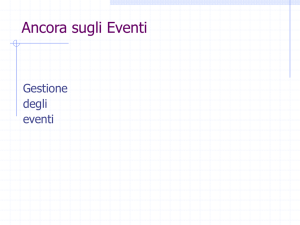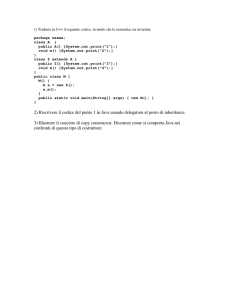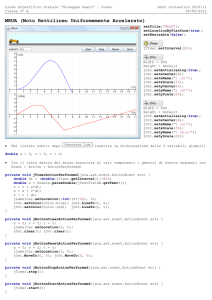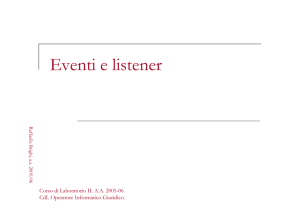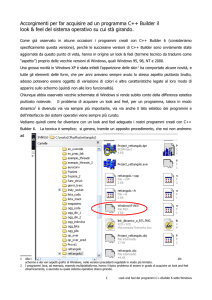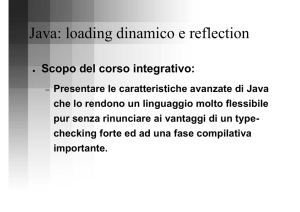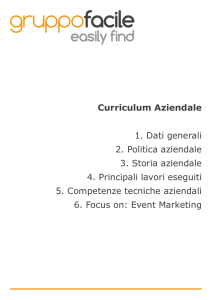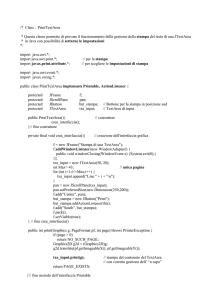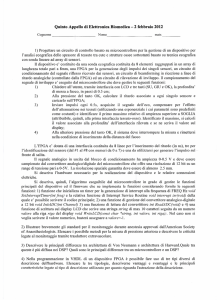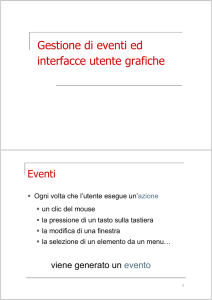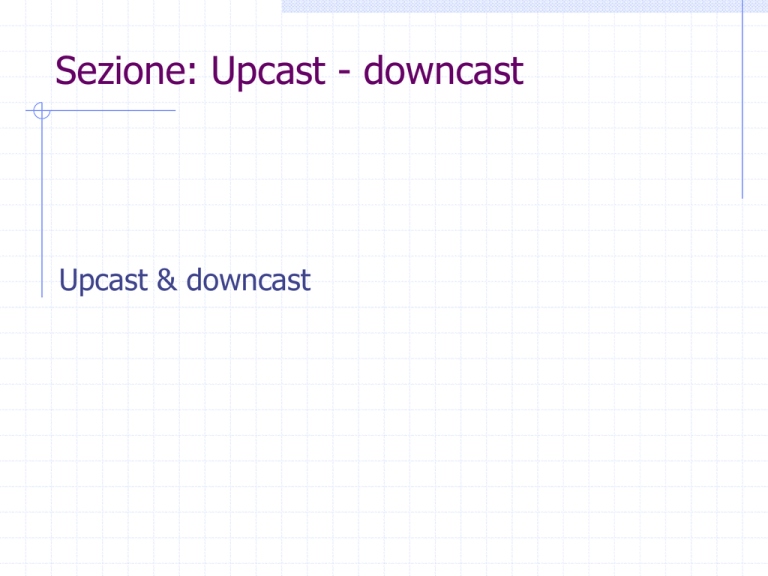
Sezione: Upcast - downcast
Upcast & downcast
Coercion
Una funzione può essere polimorfa senza essere stata
disegnata tale intenzionalmente.
Sia f una funzione che prende un argomento di tipo T, e
S sia un tipo che può essere automaticamente
convertito in T. Allora f può essere detta polimorfa
respetto a S e T.
float somma(float x, float y)
accetta anche
somma (3, 3.14)
somma(2,3)
(coercion di int a float)
public class Test {
public static void main(String a[]) {
new Test();
}
cast
Test() {
A a;
B b = new B();
OK: upcast implicito
a=b;
a.f1();
NO: "method f2 not
a.f2();
found in class A"
class A
{ void f1()
}
(compiler)
{System.out.println("f1");} }
}
class B extends A { void f2()
{System.out.println("f2");} }
class C extends B { void f3()
{System.out.println("f3");} }
public class Test {
public static void main(String a[]) {
new Test();
}
cast
Test() {
A a;
B b = new B();
OK: upcast implicito
a=b;
a.f1();
OK: downcast corretto
((B)a).f2();
class A
{ void f1()
}
{System.out.println("f1");} }
}
class B extends A { void f2()
{System.out.println("f2");} }
class C extends B { void f3()
{System.out.println("f3");} }
public class Test {
public static void main(String a[]) {
new Test();
}
cast
Test() {
A a;
B b = new B();
OK: upcast implicito
a=b;
a.f1();
NO: downcast illecito (runtime)
((C)a).f3();
java.lang.ClassCastException
class A
{ void f1()
}
{System.out.println("f1");} }
}
class B extends A { void f2()
{System.out.println("f2");} }
class C extends B { void f3()
{System.out.println("f3");} }
Type conversion - cast
Si può applicare cast SOLO all’interno di una
gerarchia di ereditarietà
È consigliabile usare l'operatore instanceof per verificare prima
effettuare un downcast
if (staff[1] instanceof Manager) {
Manager n = (Manager)staff[1];
...
}
Ancora sugli Eventi
Gestione
degli
eventi
Modello 1.1
Listener interface
Component
x
AWTEvent
Event is
generated for a
component
Component has not
registered for that
event class
Event is discarded
Component has registered
for that event class
Component gets
the event
Event is
consumed
Component
passes the Event
to Listener
Listener executes
suitable method
9
multiListenerDemo
package listenersdemo;
import javax.swing.*; import java.awt.*; import java.awt.event.*;
public class MultiListener
extends JPanel implements ActionListener {
JTextArea topTextArea;
JTextArea bottomTextArea;
JButton button1, button2;
JLabel l = null;
final static String newline = "\n";
public static void main(String[] args) {
createAndShowGUI();
}
10
multiListenerDemo
private static void createAndShowGUI() {
//Create and set up the window.
JFrame frame = new JFrame("MultiListener");
frame.setDefaultCloseOperation(JFrame.EXIT_ON_CLOSE);
//Create and set up the content pane.
JComponent newContentPane = new MultiListener();
frame.setContentPane(newContentPane);
//Display the window.
frame.pack();
frame.setVisible(true);
}
11
multiListenerDemo
public MultiListener() {
super(new FlowLayout());
l = new JLabel("Cosa sento io:");
add(l);
topTextArea = new JTextArea();
topTextArea.setEditable(false);
JScrollPane topScrollPane = new JScrollPane(topTextArea);
Dimension preferredSize = new Dimension(200, 75);
topScrollPane.setPreferredSize(preferredSize);
add(topScrollPane);
l = new JLabel("Cosa sente la spia:");
add(l);
bottomTextArea = new JTextArea();
bottomTextArea.setEditable(false);
12
multiListenerDemo
JScrollPane bottomScrollPane = new JScrollPane(bottomTextArea);
bottomScrollPane.setPreferredSize(preferredSize);
add(bottomScrollPane);
button1 = new JButton("Fra Martino campanaro");
add(button1);
button2 = new JButton("Dormi tu?");
add(button2);
button1.addActionListener(this);
button2.addActionListener(this);
button2.addActionListener(new Spia(bottomTextArea));
setPreferredSize(new Dimension(400, 300));
}
public void actionPerformed(ActionEvent e) {
topTextArea.append(e.getActionCommand() + newline);
}
}
topTextArea.setCaretPosition(topTextArea.getDocument().getLe
ngth());
13
multiListenerDemo
class Spia
implements ActionListener {
JTextArea myTextArea;
public Spia(JTextArea ta) {
myTextArea = ta;
}
public void actionPerformed(ActionEvent e) {
myTextArea.append(e.getActionCommand()
+ MultiListener.newline);
}
}
myTextArea.setCaretPosition(myTextArea.getDocument().getLe
ngth());
14
Design considerations
The most important rule to keep in mind about event listeners that
they should execute very quickly. Because all drawing and eventlistening methods are executed in the same thread, a slow eventlistener method can make the program seem unresponsive and
slow to repaint itself.
You might choose to implement separate classes for different kinds of
event listeners. This can be an easy architecture to maintain, but
many classes can also mean reduced performance.
When designing your program, you might want to implement your
event listeners in a class that is not public, but somewhere more
hidden. A private implementation is a more secure
implementation.
15
Low-Level Events and Semantic Events
Events can be divided into two groups: low-level events and semantic
events. Low-level events represent window-system occurrences or
low-level input. Everything else is a semantic event.
Examples of low-level events include mouse and key events — both
of which result directly from user input.
Examples of semantic events include action and item events.
Whenever possible, you should listen for semantic events rather than
low-level events. That way, you can make your code as robust and
portable as possible. For example, listening for action events on
buttons, rather than mouse events, means that the button will
react appropriately when the user tries to activate the button
using a keyboard alternative or a look-and-feel-specific gesture.
16
Listeners/Adapters
public class MyClass implements MouseListener {
...
someObject.addMouseListener(this);
...
/* Empty method definition. */
public void mousePressed(MouseEvent e) { }
/* Empty method definition. */
public void mouseReleased(MouseEvent e) { }
/* Empty method definition. */
public void mouseEntered(MouseEvent e) { }
/* Empty method definition. */
public void mouseExited(MouseEvent e) { }
public void mouseClicked(MouseEvent e) { ...//Event listener
implementation goes here... } }
17
Listeners/Adapters
/* * An example of extending an adapter class instead of
* directly implementing a listener interface. */
public class MyClass extends MouseAdapter {
...
someObject.addMouseListener(this);
...
public void mouseClicked(MouseEvent e) {
//Event
... }
}
listener implementation goes here
18
Inner classes
//An example of using an inner class.
public class MyClass extends JFrame {
...
someObject.addMouseListener(
new MyAdapter());
...
class MyAdapter extends MouseAdapter {
public void mouseClicked(MouseEvent e){
...//Event listener implementation goes here... }
}
}
19
Anonymous Inner classes
//An example of using an inner class.
public class MyClass extends JFrame {
...
someObject.addMouseListener(
new MouseAdapter () {
public void mouseClicked(MouseEvent e){
...//Event listener implementation goes here...
}
}
);
…
}
20
Inner classes
An instance of InnerClass can exist only within an
instance of EnclosingClass and it has direct
access to the instance variables and methods
of its enclosing instance.
21
Anonymous Inner classes
//An example of using an inner class.
public class MyClass extends JFrame {
...
someObject.addMouseListener(
new MouseAdapter() {
public void mouseClicked(MouseEvent e){
...//Event listener implementation goes here... }
}
});
...
}
22
Listeners supported by all Swing components
component listener
Listens for changes in the component's size, position, or
visibility.
focus listener
Listens for whether the component gained or lost the ability to
receive keyboard input.
key listener
Listens for key presses; key events are fired only by the
component that has the current keyboard focus.
mouse listener
Listens for mouse clicks and mouse movement into or out of
the component's drawing area.
mouse-motion listener
Listens for changes in the cursor's position over the
component.
mouse-wheel listener (introduced in 1.4)
Listens for mouse wheel movement over the component.
23
Altri listeners
action
caret
change
document
undoable edit
item
list
selection
window
+ Listeners speciali per componenti specifiche
(treeNodeExpansion, ecc)
Grafica di Java
Introduzione alla
costruzione di GUI
Pluggable Look & Feel
Pluggable Look&Feel
Scelta del Look&Feel
public static void main(String[] args) {
try {
UIManager.setLookAndFeel(
UIManager.getCrossPlatformLookAndFeelClassName());
} catch (Exception e) { }
new SwingApplication(); //Create and show the GUI.
}
UIManager.getCrossPlatformLookAndFeelClassName()
Returns the Java look and feel.
UIManager.getSystemLookAndFeelClassName()
Specifies the look and feel for the current platform.
Scelta del Look&Feel
public static void main(String[] args) {
try {
UIManager.setLookAndFeel(
"com.sun.java.swing.plaf.gtk.GTKLookAndFeel");
} catch (Exception e) { }
new SwingApplication(); //Create and show the GUI.
}
UIManager.getSystemLookAndFeelClassName(String s)
Specifies the look and feel for the platform described by
“s”.
Available Look&Feel
"com.sun.java.swing.plaf.gtk.GTKLookAndFeel"
Specifies the GTK+ look and feel. Introduced in release
1.4.2.
"javax.swing.plaf.metal.MetalLookAndFeel"
Specifies the Java look and feel.
"com.sun.java.swing.plaf.windows.WindowsLookAndFeel"
Specifies the Windows look and feel. Currently, you can
use this look and feel only on Microsoft Windows
systems.
"com.sun.java.swing.plaf.motif.MotifLookAndFeel"
Specifies the CDE/Motif look and feel. This look and
feel can be used on any platform.

